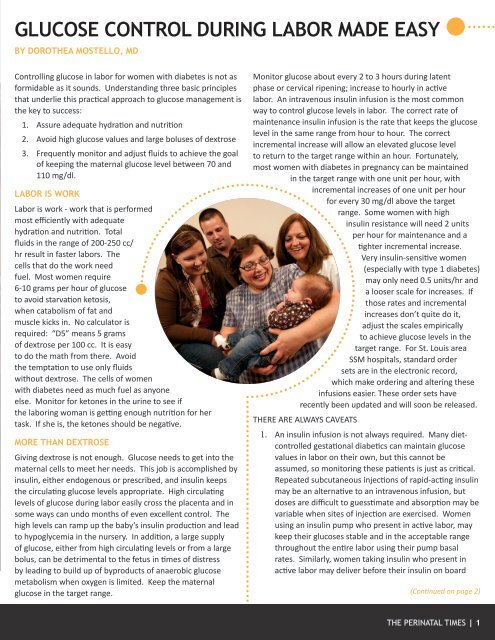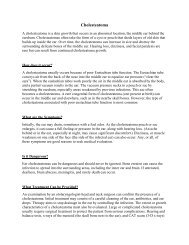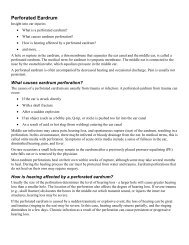perinatal-times_2013-03_print_and_read - SSM Cardinal Glennon ...
perinatal-times_2013-03_print_and_read - SSM Cardinal Glennon ...
perinatal-times_2013-03_print_and_read - SSM Cardinal Glennon ...
Create successful ePaper yourself
Turn your PDF publications into a flip-book with our unique Google optimized e-Paper software.
GLUCOSE CONTROL DURING LABOR MADE EASYBY DOROTHEA MOSTELLO, MDControlling glucose in labor for women with diabetes is not asformidable as it sounds. Underst<strong>and</strong>ing three basic principlesthat underlie this practical approach to glucose management isthe key to success:1. Assure adequate hydration <strong>and</strong> nutrition2. Avoid high glucose values <strong>and</strong> large boluses of dextrose3. Frequently monitor <strong>and</strong> adjust fluids to achieve the goalof keeping the maternal glucose level between 70 <strong>and</strong>110 mg/dl.LABOR IS WORKLabor is work - work that is performedmost efficiently with adequatehydration <strong>and</strong> nutrition. Totalfluids in the range of 200-250 cc/hr result in faster labors. Thecells that do the work needfuel. Most women require6-10 grams per hour of glucoseto avoid starvation ketosis,when catabolism of fat <strong>and</strong>muscle kicks in. No calculator isrequired: “D5” means 5 gramsof dextrose per 100 cc. It is easyto do the math from there. Avoidthe temptation to use only fluidswithout dextrose. The cells of womenwith diabetes need as much fuel as anyoneelse. Monitor for ketones in the urine to see ifthe laboring woman is getting enough nutrition for hertask. If she is, the ketones should be negative.MORE THAN DEXTROSEGiving dextrose is not enough. Glucose needs to get into thematernal cells to meet her needs. This job is accomplished byinsulin, either endogenous or prescribed, <strong>and</strong> insulin keepsthe circulating glucose levels appropriate. High circulatinglevels of glucose during labor easily cross the placenta <strong>and</strong> insome ways can undo months of even excellent control. Thehigh levels can ramp up the baby’s insulin production <strong>and</strong> leadto hypoglycemia in the nursery. In addition, a large supplyof glucose, either from high circulating levels or from a largebolus, can be detrimental to the fetus in <strong>times</strong> of distressby leading to build up of byproducts of anaerobic glucosemetabolism when oxygen is limited. Keep the maternalglucose in the target range.Monitor glucose about every 2 to 3 hours during latentphase or cervical ripening; increase to hourly in activelabor. An intravenous insulin infusion is the most commonway to control glucose levels in labor. The correct rate ofmaintenance insulin infusion is the rate that keeps the glucoselevel in the same range from hour to hour. The correctincremental increase will allow an elevated glucose levelto return to the target range within an hour. Fortunately,most women with diabetes in pregnancy can be maintainedin the target range with one unit per hour, withincremental increases of one unit per hourfor every 30 mg/dl above the targetrange. Some women with highinsulin resistance will need 2 unitsper hour for maintenance <strong>and</strong> atighter incremental increase.Very insulin-sensitive women(especially with type 1 diabetes)may only need 0.5 units/hr <strong>and</strong>a looser scale for increases. Ifthose rates <strong>and</strong> incrementalincreases don’t quite do it,adjust the scales empiricallyto achieve glucose levels in thetarget range. For St. Louis area<strong>SSM</strong> hospitals, st<strong>and</strong>ard ordersets are in the electronic record,which make ordering <strong>and</strong> altering theseinfusions easier. These order sets haverecently been updated <strong>and</strong> will soon be released.THERE ARE ALWAYS CAVEATS1. An insulin infusion is not always required. Many dietcontrolledgestational diabetics can maintain glucosevalues in labor on their own, but this cannot beassumed, so monitoring these patients is just as critical.Repeated subcutaneous injections of rapid-acting insulinmay be an alternative to an intravenous infusion, butdoses are difficult to guesstimate <strong>and</strong> absorption may bevariable when sites of injection are exercised. Womenusing an insulin pump who present in active labor, maykeep their glucoses stable <strong>and</strong> in the acceptable rangethroughout the entire labor using their pump basalrates. Similarly, women taking insulin who present inactive labor may deliver before their insulin on board(Continued on page 2)THE PERINATAL TIMES | 1
















